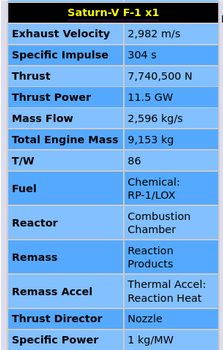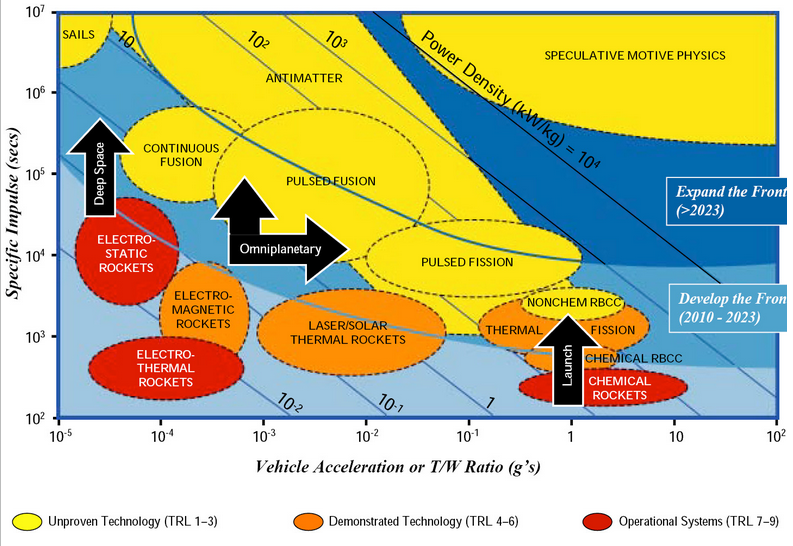The Grand Table of Newtonian Tomfoolery
AKA, the Index of Atomic Rockets engine entries
THE OBJECTIVE
of this document is to create a preliminary index of all the rockets, engines, and propulsive mechanisms indexed in the Atomic Rockets website, for purposes of creating entries similar to these in the Galactic Encyclopedia by two-person editor teams in parallel.
For a table that surveys what kind of table categories Winchell uses on the three engine list pages, please refer to the Grand Atomic Index of Tabulary Rocketry Table.
Organizational Thoughts
- Consider thermal rockets as the top level division over electric vs. chemical. The energy source is perhaps less important than the basic thrust mechanism.
- Keep scientifically outdated concepts, but mark them as such. There is value for reference and for softer sci-fi in keeping these around.
- In keeping with that point, what qualifies as “scientifically outdated” is not always clear. It would be good to support an open-ended discussion section on each engine’s knowns, unknowns, properties, things that might make it unrealistic, caveats to be aware of, etc.
- The history of how a particular rocket technology was developed may also be of interest, as a subsection on categories and on particular engines. E.g. the history for NPP is straightup hilarious (as well as being foundational and somewhat explanatory of that whole age in the contemporary sci-fi). Engine type sections could link to their own history posts.
- Densities are rarely mentioned when it comes to propellant types of any system.
- Look for holes in the existing engine list, where there is a concept that could exist but perhaps doesn’t yet, and flag for future reference.
- There is an explanation of the general principles behind the engine type (e.g. how, say, laser thermal works). Associated with the upper-level categorizations for engine types.
- Explain the most fundamental limits driving some sets of rocket/engine designs *first*, building the understanding for how from these limitations, the options we offer derive and relate to.
Other Thoughts
Regarding engine performance table in general: not just specific impulse but density impulse should be included as well
Zerraspace: I'd like to point out that there is such a huge variety of chemical rockets, even in their subfields like bipropellant and monopropellant, that perhaps rather than full entries for every combination, you give a basic principles, notes on cryogen difficulties, plus a table of performance something like Wikipedia has, before getting to specific engines or classes that deserve more information in their own right.
David B: Yes, I will take good care of commenting it
In general I would make something like
Fuel mix / optimal o.f. ratio / density / specific and density impulse (at 1atm with adapted nozzle and vacuum with high area ratio nozzle) / handling notes / a few examples of rockets using it
A description of various ways you can harvest power off of rocket engines may make sense?
Resources
Liquid Rocket Engines
Chemical rocket principles: http://www.braeunig.us/space/propuls.htm
Chemical rocket propellant performance: http://www.braeunig.us/space/propel.htm
Link to “Ignition” for the poor souls that don’t have a copy: https://library.sciencemadness.org/library/books/ignition.pdf
Electric Rocket Engines
Electrodeless plasma thrusters: https://www.researchgate.net/publication/317700959_Electrodeless_plasma_thrusters_for_spacecraft_A_review
Nuclear Pulse Engines
A declassified paper on the Orion drive: https://www.classe.cornell.edu/~seb/celestia/orion/files/19770085619_1977085619.pdf
Entry Structure Revamps
For Comparison:
Average entry engine spec table (on the bigger end):

Proposals
Zach Hajj (Zerraspace):
Under fuels, have a main header including a range of key parameters to be expected, plus key features. An example for chemical rockets could look something like this:
Exhaust Velocity: 1.5 km/s - 4.5 km/s (up to 5.3 km/s possible with extreme combinations)
Very high thrust (TWR 10-200)
As far as ‘key features’, examples include highly radioactive, needs shadow shield for NTRs, only works at large scales for nuclear pulsed propulsion, and needs active cooling for electric drives.
The idea behind this is it allows someone to quickly identify what type of drive they might want for general performance and allow them to cherry pick reasonable numbers without going through the weeds.
Extra details such as mass-flow and such, possibly in a full-on table ala Atomic Rockets, would be included under specific engines.
We may also want a table at the top of the page comparing expected properties for various engine classes, something like this:

Tags
- Real/Near - no color (either actually works or has prototypes or the principles demonstrated).
- Disproven - Orange, (disproven but still explaining the history behind it).
- Plausible - Blue, (not disproven, but has a fair chance of being real.)
- Fringe - Red, (not disproven, but probably isn’t possible at all).
- Other - Brown(either fictional or straight up doesn’t make sense, but has some merits worth including).
- Delete - strikethrough.
- Move - Green, (Movement to Other Non-Propulsion/History Sections.)
New Entries For the Galactic Library
This section is for planned entry additions to the engine lists (or revamps of them)
- Suspended nitrogen colloid
Non-nuclear Pulse Propulsion
- Quenching Superconductor Rocket (QSR)
- Nitrogen Allotrope Pellets
- Mirror Bottle Pellets
Prefix-rocket
- Turborockets
- Chemical
- Nuclear
- Ramrockets
Hybrid solid-liquid rocket engines
Having some subdivisions/variety in solid rockets might be worthwhile.
Liquid Rocket Engines
- Some of the more ‘unusual’ examples from “Ignition” such as Li-H-F rocket
- Monopropellants
- Mercury and other heavy fuels
- Chlorine trifluoride and other scary oxidizers
Detonation engines
(both RDE and PDE), since they’ve been a hot topic recently
Cold gas thrusters
List of Engines from Atomic Rockets
Engine List 1:
Beamed Power
Laser Thermal
Laser Sail
Solar Moth
Chemical
Storeable vs Cryogenic
Solid Rocket
Liquid Rocket
Methane-Oxygen
Hydrogen-Fluorine
Hydrogen-Oxygen
RP-1 - Oxygen
Hypergolic Fuels
Hybrid Rocket
Aluminum-Oxygen ISRU Metal-Oxygen
Metastable
Atomic Hydrogen
Metallic Hydrogen
Metastable He*
Metastable He IV-A
Electric
Electromagnetic (Plasma)
Electrodeless plasma
Helicon Double Layer (HDLT)
Magnetoplasmadynamic (MPD)
Pulsed Inductive (PIT)
Pulsed Plasma (PPT)
Pulsed Plasmoid (ELF)
Pulsed Plasmoid (Alfvenic)
VASIMR
Electrostatic
Electrostatic Propellant
Colloid
Field-Emission Electric (FEEP)
Hall Effect (HET)
Ion
Radioisotope Electrostatic
( IBS Agamemnon )
Electrothermal
ArcJet
Hybrid ArcJet
Nuclear Advanced Thermodynamic Cycle
Integrated NTR-ArcJet
Serpent Nuclear-Thermal-Electric Engine
Microwave Electrothermal
Resistojet
Wakefield E-Beam
Sail
Electric Sail
Magnetic Sail
M2P2
MagBeam
Photon Sail
Plasma Magnet
Q-Drive
Other
Mass Driver
Photon
Motovilov Field Drive
Tachyon
( Langston Photon )
( Beer )
Engine List 2:
Nuclear Thermal
Solid Core
NERVA
Pewee-class
SNRE-class
Cermet
Composite/Cermet Comparison
NERVA Derivative
DUMBO
Pebble Bed
Project Timberwind
INsTAR
Pulsed Solid-core NTR
Russian Twisted Ribbon
Low Pressure NTR
LANTR
Bi-Modal NTR
MITEE
- Basic
- Monatomic H
- Hybrid
Liquid Core
LARS
Centrifugal NTR
Droplet Core
Vapor Core
Colloid-Core
Gas Core
Closed Cycle
NASA Report
UAC Report
Squeezing The Last Drop Report
Pulsed Close Cycle
Open Cycle
General Open Cycle
Hybrid-Fuel
Coaxial
Vortex Confined
Wheel Flow
- MHD Driven Rotation
Fissioning Plasma Core
RD-600: Soviet bimodal GCNTR
Nuclear Salt Water
Lithium Salt Water
Fission Fragment Type
Fission Fragment
Afterburner Fission Fragment
Fission Sail
Antimatter-Driven Sail
Fizzer
Fizzer
Engine List 3:
Antimatter
Antimatter History
Antimatter Energy
Radiation Shielding
Solid Core
Gas Core
Plasma Core
Antimatter Bottle
Beam Core
Laser Core
Positron Ablative
Fusion
Fusion Fuels
Deuterium-Tritium
Hydrogen-Boron
Helium3-Deuterium
Confinement
Inertial Confinement
Electrostatic Inertial
Magnetic Confinement
- Linear Fusion
- Toroidal Fusion
- Direct Fusion Drive
Flow-Stabilized Z-Pinch
Magneto Inertial Confinement
Fusion Engines
Pure Fusion Engines
Afterburner Fusion Engines
Dual-Mode Fusion Engines
Breeder Fusion Engine
Deuterium Microbomb
Thermonuclear Orion
Nuclear Magnetic Spin Alignment
( STARFIRE Fusion Afterburner )
( AV:T Fusion )
( THS Fusion Pulse )
( Epstein Drive )
Pulse
Orion
The Death of Project Orion
Orion Thrust and Isp
Orion Environmental Impact
Weaponized Orion
- Excalibur
- NUKEDAR
- Casaba Howitzer
- SNAK
Atomic Manhole Cover
Zeta-Pinch
Zeta-Pinch Fission
- Mini-Mag Orion
- Z-pinch Microfission
- n-Li6 Microfission
Zeta-Pinch Fusion
More
PuFF Pulsed Fission Fusion
Medusa
Inertial Confinement
Magneto Inertial Fusion
Thio MTF
HOPE (MTF)
Slough FDR
Plasma Jet MIF
Antimatter catalyzed
AIM
ACMF
Radioisotope Positron
Credits:
- Tshhmon, for moving the page from Google Docs